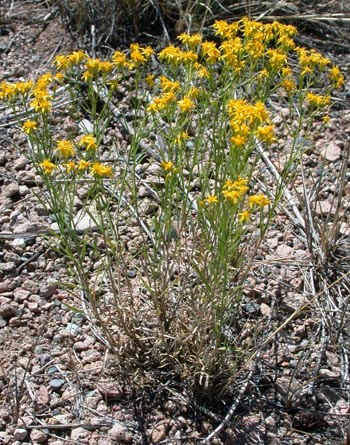Broom Snakeweed

Common Name(s):
Broom snakeweed
Snakeweed
Scientific Name:
Gutierrezia sarothrae (Pursh) Britt. & Rusby
Scientific Name Synonyms:
Xanthocephalum sarothrae (Pursh) Shinners
Solidago sarothrae Pursh
Symbol:
GUSA2
Description:
Life Span: Perennial
Origin: Native
Season: Warm (Short day)
Growth Characteristics: Broom snakeweed is a bushy, short-lived, native, perennial shrub or subshrub that grows from 8 to 28 inches in height. It flowers August to October, reproduces from seeds. Maximum life span approximately 20 years.
Flowers/Inflorescence: Numerous heads are arranged in a flat-topped cluster, which is rounded and loose. The flower heads are small, with yellow ray flowers. The bracts are leathery, shiny, green-tipped.
Fruits/Seeds: Fruit is oval and covered with chaffy scales. A brown, densely hairy, seed.
Leaves: Alternate, threadlike leaves which are folded. The margins are entire. Glands on the leaves do produce resin, making the leaves slightly sticky.
Stems: Twigs erect, thin, flexible, green to brown, and can be hairy or smooth. Trunk is short with brown bark which is shreddy and smooth. Stems die back in the winter giving the plant its broom-like appearance.
Ecological Adaptions:
Broom snakeweed occurs on rocky plains, dry foothills, ridgetops, and mountain slopes, and in semi-desert valleys. High water use efficiency and a high degree of drought tolerance enable broom snakeweed to survive on arid or semi-arid sites.
Soils: Broom snakeweed occurs on a wide range of soil types including dry, well drained, sandy, gravelly, or clayey loams and heavy clays. Growth is reportedly best on clay loams of broad alluvial slopes, and shallow, rocky, or sandy soil. Growth is generally poor on saline or alkaline soils.
Associated Species: Big sagebrush, western wheatgrass, sandberg bluegrass, cheatgrass, curlycup gumweed.
Uses and Management:
Snakeweed provides little browse for domestic livestock. It is of minimal value to cattle and horses, but does provide fair quality winter browse for domestic sheep when green forage is scarce or lacking. It is otherwise worthless and can be an indicator of overgrazing. It's populations are also heavily cyclical, and heavy infestation can be and indicator of weather conditions rather than overgrazing. Broom snakeweed can be toxic to domestic sheep, goats, and cattle particularly during winter or early spring when poor forage availability forces animals to consume large quantities. Saponins present in the foliage are responsible for the poisoning, and can cause illness, death, or abortion in livestock. However, toxicity apparently varies with phenological stage and substrate. Higher toxicity levels are often associated with periods of rapid growth, such as early leaf development, and with growth on sandy rather than calcareous soils. Broom snakeweed is also a secondary or facultative absorber of selenium, which may cause illness or death when consumed in quantity.
This plant is commonly confused with rabbitbrush, but it can be distinguished by the presence of ray flowers. Rabbitbrush plants have none, nor do the stems die back in the winter.
Southwestern Indians and Mexicans used snakeweed as a broom. Decoctions were used for indigestion. Pieces of the plant were chewed and placed on bee and wasp stings.

